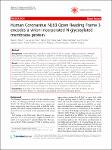Human Coronavirus NL63 Open Reading Frame 3 encodes a virion-incorporated N-glycosylated membrane protein
Müller, Marcel A.
Hoek, Lia van der
Voss, Daniel
Bader, Oliver
Lehmann, Dörte
Schulz, Axel R.
Kallies, Stephan
Suliman, Tasnim
Fielding, Burtram C
Drosten, Christian
Niedrig, Matthias
Background: Human pathogenic coronavirus NL63 (hCoV-NL63) is a group 1 (alpha) coronavirus commonly associated with respiratory tract infections. In addition to known non-structural and structural proteins all coronaviruses have one or more accessory proteins whose functions are mostly unknown. Our study focuses on hCoV-NL63 open reading frame 3 (ORF 3) which is a highly conserved accessory protein among coronaviruses. Results: In-silico analysis of the 225 amino acid sequence of hCoV-NL63 ORF 3 predicted a triple membrane-spanning protein. Expression in infected CaCo-2 and LLC-MK2 cells was confirmed by immunofluorescence and Western blot analysis. The protein was detected within the endoplasmatic reticulum/Golgi intermediate compartment (ERGIC) where coronavirus assembly and budding takes place. Subcellular localization studies using recombinant ORF 3 protein transfected in Huh-7 cells revealed occurrence in ERGIC, Golgi- and lysosomal compartments. By fluorescence microscopy of differently tagged envelope (E), membrane (M) and nucleocapsid (N) proteins it was shown that ORF 3 protein colocalizes extensively with E and M within the ERGIC. Using N-terminally FLAG-tagged ORF 3 protein and an antiserum specific to the C-terminus we verified the proposed topology of an extracellular N-terminus and a cytosolic C-terminus. By in-vitro translation analysis and subsequent endoglycosidase H digestion we showed that ORF 3 protein is N-glycosylated at the N-terminus. Analysis of purified viral particles revealed that ORF 3 protein is incorporated into virions and is therefore an additional structural protein. Conclusions: This study is the first extensive expression analysis of a group 1 hCoV-ORF 3 protein. We give evidence that ORF 3 protein is a structural N-glycosylated and virion-incorporated protein.
Dateien zu dieser Publikation
Keine Lizenzangabe

